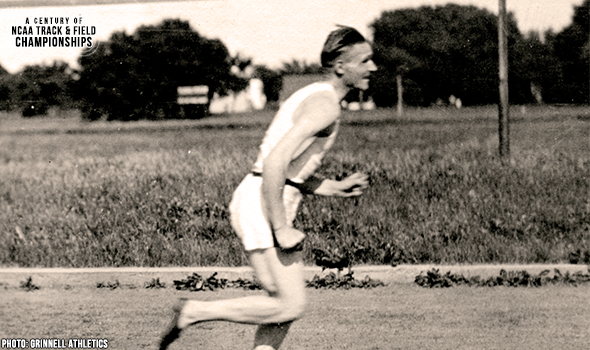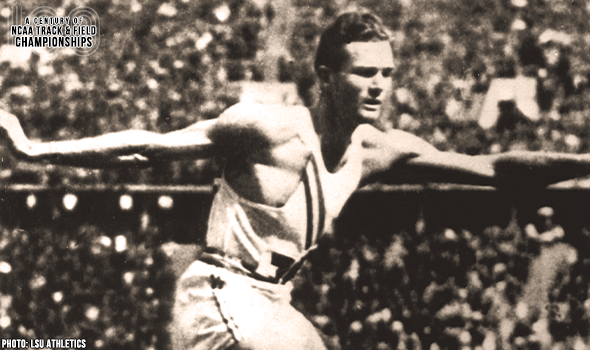
Patton Left Legendary Mark On NCAA Sprints
In the heats of the 1947 NCAA Championships, Mel Patton of Southern California equaled the 100-yard world record of 9.4, but amazingly he didn’t get any credit for the world record.
Even though the wind reading was 1.9 meters per second – less than the legal limit of 2.0 required by the IAAF and AAU – NCAA rules at the time had a limit of 3 miles per hour (1.3 m/s), so the performance was not submitted as a world record. (The NCAA changed its rule to 2.0 m/s the next year.)
It wouldn’t be the last time that Patton – who went on to win the first of his five NCAA sprint titles – lost world record recognition over inconsistent rules.
It happened again in 1948, but this time in the 200 meters as Patton followed up his first NCAA sprint double with an Olympic Trials win in the 200. The 200 that year was held on a turn – just as in the London Olympics that he won later that summer were – and Patton ran 20.7, equal to the fastest ever.
At least Patton was in great company: The other 20.7 belonged to none other than Jesse Owens when he won gold at the 1936 Olympics. (The IAAF did not recognize races on curves for record status until 1951.)
Did Patton ever get credit for a world record? Yes, and two of his most remarkable WRs happened in a week’s time to better a pair by Owens from his famous Day of Days at the 1935 Big Ten Championships.
In the 1949 USC-UCLA dual meet, Patton – nicknamed “Pell Mel” – ran a straightaway 220 yards in 20.2 to break Owens’ WR of 20.3, then a week later followed it with history’s first 9.3 100 yards.
Of the 9.3, Patton commented, “I can hardly believe it is true. I really don’t believe I was going as fast as that. It didn’t feel to be my fastest race.”
Patton completed a second-straight 100/200 double at the NCAA Championships in 1949, winning both at the Los Angeles Memorial Coliseum, nearly on the USC campus. His five NCAA outdoor sprint titles is one short of the all-time best of six set by Marquette’s Ralph Metcalfe (1932-34).
The NCAA and collegiate track & field will mark a momentous milestone in the spring of 2021 -- the 100th anniversary of the NCAA Championships and with that, the NCAA Track & Field Championships. In June 1921, the University of Chicago hosted the first track & field championships in NCAA history.
This point can’t be emphasized enough: Not only was the event the first for NCAA track & field, but the first championships for any sport under the sponsorship of the NCAA.
To celebrate, over each of the next 365 days, the U.S. Track & Field and Cross Country Coaches Association (USTFCCCA) will celebrate moments, student-athletes, and coaches that have made a century’s worth of championships special. From humble beginnings to important historical milestones to the modern-day, collegiate track & field has evolved with the American society.
The 2021 edition of the NCAA Division I Outdoor Track & Field Championships begin with preliminary round action on May 27-29 in Jacksonville, Fla., and College Station, Texas. The championships final site and culmination of the celebration is slated for June 9-12, 2021 at the newly rebuilt Hayward Field in Eugene, Ore.

SIU’s Roggy Dominated The Javelin In 1978
Bob Roggy won the javelin title at the 1978 NCAA DI Outdoor T&F Championships by more than 20 feet. Roggy qualified first for the final with a MR heave of 89.30m (293‑0).

Makusha Made History In Bowerman Year Of 2011
Ngoni Makusha became just the fourth man in meet history to win individual titles in both the 100 and LJ. It was his 3rd career LJ crown and he set a CR in the 100 of 9.89.

George Mason’s Gage Shocked The NCAA LJ In 1988
Nena Gage won the long jump at the 1988 NCAA DI Outdoor T&F Championships in a shocking upset over Gail Devers.

Texas’ Thompson Marveled In NCAA Distance Events
Jerry Thompson won three career distance titles at the NCAA Outdoor T&F Championships. His first came in 1943. Then he won again in 1947 & 1948 after serving in World War II.

Grinnell’s Paulu Sprinted To NCAA History
Leonard Paulu was the first athlete to complete the 100-200 double in NCAA Outdoor Track & Field Championships history in 1922. That also made him the 1st to win back-to-back 100 titles, too.

Scott Won Back-To-Back NCAA Hammer Titles
Candice Scott won back-to-back hammer throw titles at the NCAA DI Outdoor T&F Championships in 2003 & 2004. Scott set a meet record of 69.77m (228-11) in that first year.

Drouin Soared To The Bowerman In 2013
Derek Drouin won two career HJ titles at the NCAA DI Outdoor T&F Championships. When Drouin won in 2013, he was only the fourth man to clear 2.34m (7-8) in meet history.

Watts Made Quick Work Of NCAA 400
Quincy Watts set a meet record in the 400 of 44.00 at the 1992 NCAA DI Outdoor Track & Field Championships. It lasted 25 years until 2017.

Iowa State’s Koll Rolled To 5K-10K Crowns
Lisa Koll won three career titles at the NCAA DI Outdoor T&F Championships in dominant fashion. Her average margin of victory in those 5K & 10K races was 37.73 seconds.

LSU’s Hardin Completed Unique 440-220H Double Twice
The nearly unheard of 440-220H double was so nice that Glenn Hardin did it twice! Hardin became the first to do so in meet history in 1933 and then swept them again in 1934.

